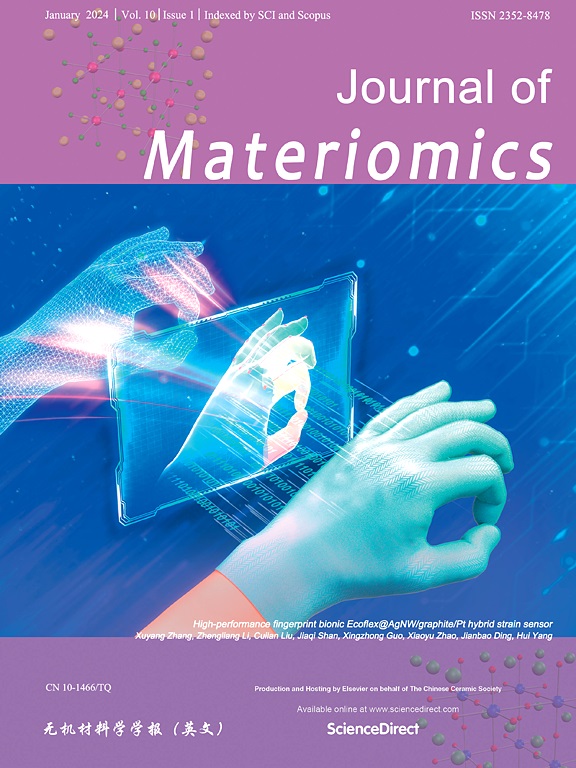A new-type electro-optic crystal: K3Nb3B2O12
IF 9.6
1区 材料科学
Q1 CHEMISTRY, PHYSICAL
引用次数: 0
Abstract
Electro-optical materials are crucial for lasers and modulators applications. Perovskite ferroelectric crystals, characterized by oxygen octahedrons and superior dipole migration capabilities, are recognized for their high electro-optic coefficients. However, the application of perovskite ferroelectric crystals is often limited by reduced optical transparency, which results from light scattering and reflection at domain walls. In this study, we implemented a structure dimensionality reduction strategy to successfully transform a three-dimensional structure KNbO3 (KNO) crystal into a quasi-two-dimensional layered structure K3Nb3B2O12 (KNBO) crystal through BO3 planar groups. This modification restricts the mobility of B-site ions within the layers while preserving significant spontaneous polarization along the interlayer direction, thus converting multipolar axis into a unipolar axis in the ferroelectric. This alteration in the direction of spontaneous polarization modifies the domain structure, thereby minimizing the scattering effects of the domain walls. As a result, the KNBO crystal exhibits a large effective electro-optic (EO) coefficient of 50.14 pm/V and a high transmittance exceeding 80% in the 330–2500 nm wavelength range. These properties surpass those of currently available commercial EO crystals. This research establishes a model for enhancing transparency and EO coefficient through structural design, offering potential applications to other EO crystals.


新型电光晶体:K3Nb3B2O12
电光材料是激光器和调制器应用的关键。钙钛矿铁电晶体以氧八面体和优越的偶极子迁移能力为特征,具有较高的电光系数。然而,钙钛矿铁电晶体的应用往往受到光学透明度降低的限制,这是由光散射和反射在畴壁造成的。在这项研究中,我们实施了结构降维策略,成功地将三维结构的KNbO3 (KNO)晶体通过BO3平面基团转化为准二维层状结构的K3Nb3B2O12 (KNBO)晶体。这种修饰限制了b位离子在层内的迁移,同时保留了沿层间方向的显著自发极化,从而将铁电中的多极轴转化为单极轴。这种自发极化方向的改变改变了畴结构,从而使畴壁的散射效应最小化。结果表明,该晶体在330 ~ 2500 nm波长范围内具有50.14 pm/V的有效电光(EO)系数和超过80%的高透射率。这些性能超过了目前可用的商业EO晶体。本研究建立了一个通过结构设计来提高透明度和EO系数的模型,为其他EO晶体提供了潜在的应用前景。
本文章由计算机程序翻译,如有差异,请以英文原文为准。
求助全文
约1分钟内获得全文
求助全文
来源期刊

Journal of Materiomics
Materials Science-Metals and Alloys
CiteScore
14.30
自引率
6.40%
发文量
331
审稿时长
37 days
期刊介绍:
The Journal of Materiomics is a peer-reviewed open-access journal that aims to serve as a forum for the continuous dissemination of research within the field of materials science. It particularly emphasizes systematic studies on the relationships between composition, processing, structure, property, and performance of advanced materials. The journal is supported by the Chinese Ceramic Society and is indexed in SCIE and Scopus. It is commonly referred to as J Materiomics.
 求助内容:
求助内容: 应助结果提醒方式:
应助结果提醒方式:


